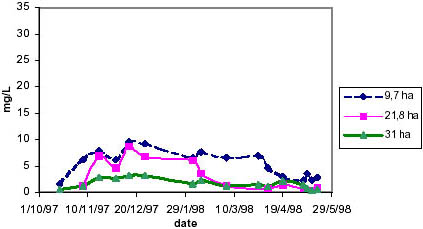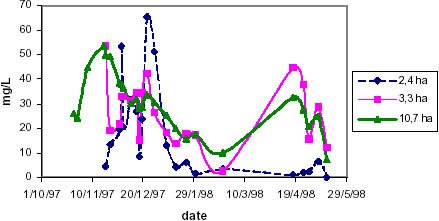SUMMARY
The chemical composition of little streams in two agricultural grassland dominated catchments, was analysed during the rainy season 1997-1998, allowing a study of denitrification. The first catchment was characterized by diffuse contamination sources, resulting mainly from cattle grazing and slurry spreading; most of the pastures were located near the head of the catchment and nitrate contents of the stream decreased from upland to the outlet in lowland. In the second catchment, in addition to diffuse pollution, a point source of nitrate was located, i.e. sewage sludge from a pig farm was discharged; denitrification was found to be less effective. Results also highlighted the value of establishing buffer zones alongside channels to maintain or improve stream water quality.
Keywords: agricultural pollution, catchment, denitrification, nitrate, surface water
INTRODUCTION
Nitrogen transfer from soil may occur along a number of hydrological pathways. Spatial and temporal factors can influence the form and rate of nitrogen transfer along these pathways, including hydrology, soil texture, land use management practices and soil nitrogen status and load (Addiscott et al., 1991; Oenema and Roest, 1998). Thus, good environmental management depends on accurate recognition of how particular catchments function and on the understanding of the ways in which soils can help buffer or are tolerant of human activities in the landscape.
The effective control of nitrogen losses to water bodies requires that management strategies target “hot-spots” within agricultural catchments ensuring efficient deployment of resources. The identification of areas vulnerable to transfer processes is necessary if remediation measures for the control of N pollution are to be implemented successfully.
During the last decade, concern over the impact of diffuse pollution of prairies on fresh water quality has been widespread in different areas of the Spanish humid zone (Díaz-Fierros et al., 1988; Carballas and Díaz-Fierros, 1990). This paper compares nitrate contents in streams draining two agriculturally dominated catchments from two regions of Galicia (NW Spain) which contrast greatly with respect to physical factors (climate, topography, soil type), agricultural practices and sources of nitrogen. The data presented here provides an overview of the nitrate concentrations monitored during the rainy season 1997-1998.
MATERIAL AND METHODS
Two catchments were selected in the provinces of Lugo and La Coruña (Galicia, NW Spain) representing inherently distinct regions in terms of climate, land use and agricultural practices. The selected elementary catchments are locally called Seixas (Lugo) and Abelar (La Coruña). The size of Seixas is approximately 31 ha and Abelar is 10.7 ha. They are isolated by its position near the head of large river basins and drain via a small flowing stream at its base, which receives all its drainage water. Within each study area, two subcatchments were delineated by smaller watercourses joining the main stream. The streams dried up in summer. In both sites, soils are mainly medium textured and rich in organic matter umbrisols; hydromorphic features are identified in some waterlogged zones.
In Seixas the mean slope is 22 percent. Land use is a complex mixture of maintained grassland, rough grazing (cattle), arable and woodland and heathland cover. Pastures are mainly located in uplands. The use of inorganic fertilizer N varies, but it is smaller than organic input, farmyard manure and slurry spreading being the dominant forms of livestock waste used in this catchment. Thus, surface waters received nitrates by diffuse processes. Total rainfall for the study period (1 October 1997 to 31 May 1998) was 952.9 mm. Water samples were taken at the outlet of the main catchment (31 ha) and upslope in surface channels draining subcatchments of 21.8 and 9.7 ha of size.
Abelar catchment has a rolling topography, the mean slope being 6.9 percent. Most of the land in this catchment consists of a grassland (58.6 percent), not considered intensive; additional land uses are a maize field (37.2 percent) and a small patch of scrub (4.2 percent). This site is impacted by high nutrient loads resulting from both, more intensive land use than Seixas and point discharge of pig slurry at the head of the catchment by means of a pumping system. Rainfall between 1 October 1997 and 31 May 1998 was 1 390.7 mm. For sampling purposes the outlet of the 10.7 ha main catchment and two subcatchments of 2.4 and 3.3 ha were taken into account.
The water sampling programme involves taking samples from three of the above-mentioned locations along streams at each catchment. The sampling period ranges from a few days to a month. Samples were analysed for a range of water quality parameters, including nitrate concentration, that was determined by capillary electrophoresis.
RESULTS AND DISCUSSION
The timecourses of monitored nitrate concentrations are illustrated in Figures 1 and 2. Figure 1 clearly shows that at the Seixas catchment the nitrate concentration varies with distance to the outlet, increasing progressively from forested lowland to cultivated upland. Thus, nitrate contents at the outlet of the 31 ha mixed agricultural and forestry catchment ranged from 3.25 to 0.39 mg/l, whereas at the 9.7 ha grassland dominated catchment, they ranged from 9.57 to 2.25 mg/l.
Furthermore, the nitrate concentration was not constant over time and seemed to reach a maximum at the end of the winter, between December and February, and decreased in spring. The simultaneity of the nitrate minima in the three streams indicates that climatic conditions favoured denitrification during spring, whereas in winter, nitrate seems to be recycled less efficiently.
Stream marginal wetlands in which inundation by surface water occurs and adjacent valley slopes which are regularly affected by overland flow or have an elevated water table are sites where watterloging is of sufficient duration to enable the development of hydromorphic soils. These marginal wet zones may act as a true sink for nitrate, since the nutrient is permanently removed from the system to the atmosphere.
Figure 1. Nitrate contents monitored at the outlet of the main catchment (31 ha) and two subcatchments (21.8 and 9.7 ha) in Seixas.

Figure 2. Nitrate contents monitored at the outlet of the main catchment (10.7 ha) and two subcatchments (2.4 and 3.3 ha) in Abelar.

In the second site, Abelar, nitrate contents at the outlet of both main catchment and the two studied subcatchments were sometimes greater than 50 mg/l, the level above which pollution is considered to occur. The stream draining the 2.4 ha subcatchment showed nitrate peaks in November and December and afterwards nitrate content is below 7 mg/l. In contrast, the nitrate content of the adjacent 3.3 ha subcatchment continues to be relatively high after December. These differences are related to the routing pattern of the waste discharged at the point source, which was directed first throughout both subcatchments and since January through the 3.3 ha one.
Nitrate contents in the collected water at the main catchment outlet ranged from 7.3 to 53.5 mg/l. Nitrate concentrations can even be higher than in the subcatchment level, indicating that denitrification in Abelar was less effective than in Seixas. The scarce buffer capacity of Abelar catchment could be the consequence of a hydrological connection via a main channel between the subcatchments and the main catchment outlet. Thus, this site can be considered as environmentally very poorly managed.
CONCLUSIONS
Nitrate dynamics vary temporally and spatially within and among streams. Various hydrological, chemical and biological interactions control nitrate concentrations and water quality. In the two catchments studied, important variations in nitrate content of the streams were monitored and were found to be due to location of nitrogen sources, distribution of vegetation cover and soil type and hydrological system.
ACKNOWLEDGEMENTS
This research is being financed by CICYT. Project HID96 - 1085 - C02.
REFERENCES
Addiscott, T.M., Whitmore, A.P. & Powlson, D.S. 1991. Farming, Fertilizers and the Nitrate Problem. CAB International. Wallingford.
Carballas, T. & Díaz-Fierros, F. 1990. El purín de vacuno en Galicia. Caracterización, poder fertilizante y problemas ambientales. Xunta de Galicia. COTOP. 162 pp.
Díaz-Fierros, F., Villar, M.C., Carballas, M., Leirós, M.C., Carballas, T. & Cabaneiro, A. 1988.
Effects on cattle slurry fractions on nitrogen mineralization. Soil Journal Agricultural Science 108, 353-359.
Oenema, O. & Roest, C.W. 1998. Nitrogen and phosphorus losses from agriculture into surface waters; the effects of policies and measures in the Netherlands. Water Science Technology 37: 19-30.
|
[6] Facultad de Ciencias,
Universidad de La Coruña, Spain [7] EPS de Lugo, Universidad de Santiago de Compostela, Spain [8] Facultad de Ciencias, Universidad de La Coruña, Spain [9] Facultad de Ciencias, Universidad de La Coruña, Spain [10] Facultad de Ciencias, Universidad de La Coruña, Spain |